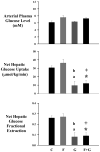Continuous low-dose fructose infusion does not reverse glucagon-mediated decrease in hepatic glucose utilization
- PMID: 20940071
- PMCID: PMC3736817
- DOI: 10.1016/j.metabol.2010.08.006
Continuous low-dose fructose infusion does not reverse glucagon-mediated decrease in hepatic glucose utilization
Abstract
An adaptation to continuous total parenteral nutrition (TPN; 75% of nonprotein calories as glucose) is the liver becomes a major consumer of glucose with lactate release as a by-product. The liver is able to further increase liver glucose uptake when a small dose of fructose is acutely infused via the portal system. Glucagon, commonly elevated during inflammatory stress, is a potent inhibitor of glucose uptake by the liver during TPN. The aim was to determine if continuous fructose infusion could overcome the glucagon-mediated decrease in hepatic glucose uptake. Studies were performed in conscious, insulin-treated, chronically catheterized, pancreatectomized dogs that adapted to TPN for 33 hours. They were then assigned to 1 of 4 groups: TPN (C), TPN + fructose (4.4 μmol kg(-1) min(-1); F), TPN + glucagon (0.2 pmol kg(-1) min(-1); GGN), or TPN + fructose and glucagon (F + GGN) for an additional 63 hours (33-96 hours). Insulin, fructose, and glucagon were infused into the portal vein. During that period, all animals received a fixed insulin infusion of 0.4 mU·kg(-1)·min(-1) (33-96 hours); and the glucose infusion rates were adjusted to maintain euglycemia (6.6 mmol/L). Continuous fructose infusion was unable to further enhance net hepatic glucose uptake (in micromoles per kilogram per minute) (31.1 ± 2.8 vs 36.1 ± 5.0; C vs F), nor was it able to overcome glucagon-mediated decrease in net hepatic glucose uptake (10.0 ± 4.4 vs 12.2 ± 3.9; GGN vs F + GGN). In summary, continuous fructose infusion cannot augment liver glucose uptake during TPN; nor can it overcome the inhibitory effects of glucagon.
Copyright © 2011 Elsevier Inc. All rights reserved.
Conflict of interest statement
Figures

Similar articles
-
Fructose augments infection-impaired net hepatic glucose uptake during TPN administration.Am J Physiol Endocrinol Metab. 2001 May;280(5):E703-11. doi: 10.1152/ajpendo.2001.280.5.E703. Am J Physiol Endocrinol Metab. 2001. PMID: 11287352
-
Impact of chronic fructose infusion on hepatic metabolism during TPN administration.Am J Physiol Endocrinol Metab. 2002 Dec;283(6):E1151-8. doi: 10.1152/ajpendo.00223.2001. Am J Physiol Endocrinol Metab. 2002. PMID: 12424103
-
Small amounts of fructose markedly augment net hepatic glucose uptake in the conscious dog.Diabetes. 1998 Jun;47(6):867-73. doi: 10.2337/diabetes.47.6.867. Diabetes. 1998. PMID: 9604861
-
Effects of fructose on hepatic glucose metabolism.Curr Opin Clin Nutr Metab Care. 2003 Jul;6(4):441-8. doi: 10.1097/01.mco.0000078990.96795.cd. Curr Opin Clin Nutr Metab Care. 2003. PMID: 12806219 Review.
-
Control of hepatic glucose output by glucagon and insulin in the intact dog.Biochem Soc Symp. 1978;(43):31-45. Biochem Soc Symp. 1978. PMID: 373768 Review.
Cited by
-
Perioperative Nutritional Aspects in Total Pancreatectomy: A Comprehensive Review of the Literature.Nutrients. 2021 May 22;13(6):1765. doi: 10.3390/nu13061765. Nutrients. 2021. PMID: 34067286 Free PMC article.
-
Dietary sugar and body weight: have we reached a crisis in the epidemic of obesity and diabetes?: health be damned! Pour on the sugar.Diabetes Care. 2014 Apr;37(4):950-6. doi: 10.2337/dc13-2085. Diabetes Care. 2014. PMID: 24652725 Free PMC article. Review.
-
Liver, but not muscle, has an entrainable metabolic memory.PLoS One. 2014 Jan 23;9(1):e86164. doi: 10.1371/journal.pone.0086164. eCollection 2014. PLoS One. 2014. PMID: 24465939 Free PMC article.
References
-
- van den Berghe G, Wilmer A, Hermans G, et al. Intensive Insulin Therapy in the Medical ICU. N Engl J Med. 2006;354:449–461. - PubMed
-
- van den Berghe G, Wouters P, Weekers F, et al. Intensive insulin therapy in the critically ill patients. N Engl J Med. 2001;345:1359–1367. - PubMed
-
- Robinson LE, van Soeren MH. Insulin resistance and hyperglycemia in critical illness: role of insulin in glycemic control. AACN Clin Issues. 2004;15:45–62. - PubMed
-
- The NICE-SUGAR Study Investigators. Intensive versus Conventional Glucose Control in Critically Ill Patients. N Engl J Med. 2009;360:1283–97. - PubMed
-
- Balasubramanyam A. Intensive Glycemic Control in the Intensive Care Unit: Promises and Pitfalls. J Clin Endocrinol Metab. 2009;94:416–417. - PubMed
Publication types
MeSH terms
Substances
Grants and funding
LinkOut - more resources
Full Text Sources
Research Materials
Miscellaneous

